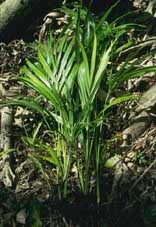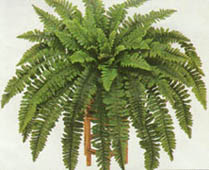Indoor Tropical Plants can Detoxify Air
At least 300 volatile substances found inside many buildings, from detergents, gasoline, oils, plastics, rubber, synthetic fibres, tobacco, smoke, carpet, clothes, foam insulation, furniture, household cleaners, paper goods, dry cleaning, inks, lacquers, creosote, varnishes, adhesives, sealants, paints, partcleboard, plywood, timber treatments, are all potential causes of ailments in humans. Among the common ailments attributed to indoor 'offgassing' are headaches, asthma, unnatural fatigue, conjunctivitis, chemical hypersensitivity syndrome and chronic degenerative conditions.
Since research indicates that people spend approximately 90 percent of their time indoors, and consume 15kg of air a day compared with 1kg of food, the maintanance of indoor air quality is an important step in avoiding the cumulation of toxins.
Bill Wolverton was asked by Nasa back in 1973 to find a solution to maintaining air quality inside confined spaces such as space pods. He confirmed the common intuition that indoor plants regularly remove pollutants. Photosynthesizing plants and their roots and associated microorganisms act to break down contaminants which are then taken up as nutrients. He discovered that Boston fern, chrysanthemum, dracaena and Ivy were highly effective at removing the formaldhyde, benzene and trichloroethylene from sealed chambers.
| Removal of Formaldehyde from Sealed
Chambers by Plants |
||
| Scientific Name |
Common Name |
Removal Rate ug (micrograms)/hr |
| 1. Nephrolepsis Exaltata 2. Chrysanthemum morifolium 3. Gerbera Jarnesonii 4. Phoenix roebelenii 5. Chamaedorea seifritzii 6. Dracanena derenebsis 7. Nephrolepsis obliterata 8. Hedera helix |
Boston Fern Chrysanthemum Gerbera daisy Dwarf date palm Bamboo palm Janet craig Kimberly queen fern English Ivy |
1863 1453 1400 1385 1350 1361 1328 1120 |
| Removal of Xylene from Sealed
Chambers by Plants |
||
| Scientific Name |
Common Name |
Removal Rate ug (micrograms)/hr |
| 1. Chrysalidocarpus lutescens 2. Phoenix roebelenii 3. Dieffenbachia carnille 4. Lracana marginata 5. Dieffenbachia maculata 6. Homalomena 7. Nephrolepsis obliterata 8. Draceana deremensis |
Areca palm Dwarf date palm Dumb cane Dragon tree Dumb cane King of Hearts Kimberly queen fern Warneckei |
654 610 341 338 325 325 323 295 |
The most commonly available plants on this list are the
Boston Fern (Nephrolepsis exaltata), Areca Palm (Chrysalidocarpus
lutescens), the Spider Plant (Chlorophytum comosum), and English
Ivy (Hedera helix). Since different
plants absorb different pollutants, a mix of a minimum of two plants
per 100 square feet of floor space in an average home is recommended, but
basically, the more the better.
| Spider Plant |
Areca Palm |
Ivy |
Boston Fern |
 |
 |
 |
 |
Bibliography
"Tropical Plants Clean up the Air" by David Foster at the 3rd Indoor Air Quality Conference June 1995
"Danger Chemicals get EU all-clear for continued Use" Paul Brown and Andrew Osborn in Brussels, The Guardian
UNIT 5 Study Book Feb 2003 University of East London & Centre for Alternative Technology MSc Architecture

